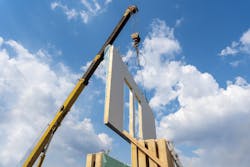Exploring the use of alternative methods and materials, such as structural insulated panels and modular construction, has been one way some builders have responded to elevated lumber prices. MiTek, a company that provides integrated software, services, engineered products and automated solutions for the building industry, aims to further streamline modular construction by giving contractors the parts to assemble on-site rather than sending full modules. The company hopes to create an automated manufacturing process similar to car assembly lines. Another issue sparking innovation is the need for resilient homes; RSG 3D panels combine foam insulation, a steel grid, and concrete covering and withstand wildfires.
RSG 3-D’s panels — comprising foam insulation, a steel grid and concrete covering — were utilized in a northern California home that was able to withstand a devastating wildfire, prompting the question why the majority of homes are still made of wood. Time pointed to NAHB statistics regarding not only the number of homes constructed with wood, but the financial impact that the lumber crisis has had on the cost of single-family homes as potential reasons to revisit building with different materials for today’s homes.
“It’s important to look at total costs,” shared John Barrows, owner of P3 Group in Bridgehampton, N.Y., during a recent NAHB webinar exploring lumber alternatives — specifically SIPs. “As codes are becoming more stringent … conventional construction costs are being driven higher and higher by some of the things that we have to do. And by using a system such as SIPs, you’re able to accomplish that in a much more cost-effective manner to achieve the same outcomes.”
“I found on the last eight projects that building a SIP house is 2% to 3% less in direct costs over the whole project than a conventional system with insulation and air sealing to the same level,” he added.
